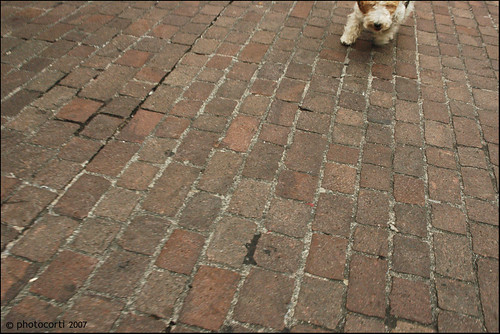il 22 agosto 2007, durante il viaggio di avvicinamento a dokumenta-kassel, ci fermiamo a solothurn (soletta il nome italiano), la più bella città barocca della svizzera.
a berna il giorno prima mi ero comprata una monografia di rudy burckhardt (phillip lopate, vincent katz, rudy burckhardt, 2004).
ero rimasta affascinata da alcuni scatti che avevano come soggetto il selciato e pezzi di passanti, e il giono dopo eccomi arrivare sotto agli occhi il cagnolino che è divenuto il mio primo cane in angolo... ho scattato, la foto mi è molto piaciuta ed è iniziata la malattia...
quindi se esistono i miei cani d'angolo è perchè è esistito rudy burckhardt e i suoi bellissimi scatti di selciati newyorkesi...
a berna il giorno prima mi ero comprata una monografia di rudy burckhardt (phillip lopate, vincent katz, rudy burckhardt, 2004).
ero rimasta affascinata da alcuni scatti che avevano come soggetto il selciato e pezzi di passanti, e il giono dopo eccomi arrivare sotto agli occhi il cagnolino che è divenuto il mio primo cane in angolo... ho scattato, la foto mi è molto piaciuta ed è iniziata la malattia...
quindi se esistono i miei cani d'angolo è perchè è esistito rudy burckhardt e i suoi bellissimi scatti di selciati newyorkesi...
ecco come il the new york times ne ha annunciato la morte il 4 agosto 1999:
rudy burckhardt, 85, photographer and filmmaker, dies
by roberta smith
rudy burckhardt, whose 60-year career as an artist and a friend of artists connected several generations and esthetic factions of the new york school, drowned on sunday in a pond near his home in searsmont. he was 85 and also had a home in manhattan.
the administrator of the office of maine's chief medical examiner said that he committed suicide.
mr. burckhardt was best known as a photographer and filmmaker whose primary subject was the new york cityscape: its people, architecture, fleeting detail and ceaseless vitality.
he painted and wrote intermittently, publishing ''mobile homes,'' a book of autobiographical essays, in 1979. the book's title was an odd but fitting choice for a man who was for so long and so quietly a constant on the new york cultural scene -- the poet john ashbery once called him a ''subterranean monument'' -- and yet moved easily between art forms and also collaborated with artists of all denominations.
mr. burckhardt was a famously diffident man, elegant, slight and soft-spoken with a habitually morose demeanor. in fact he possessed an unusually sunny personality for an artist and seemed to live in perpetual delight that the rest of the world had none of the order and homogeneity of his native city, basel, switzerland.
his career unfolded in the background of the tumultuous rise of the new york school, which was well known for its clashing egos.
for many years his most visible profile was as a photographer whose images of artists and their work were frequently featured in art news magazine, where he used the credit rudolph burckhardt.
even today he may be most familiar to many people interested in american art as a name that appears in other artists' biographies: as the next door neighbor of the young willem de kooning, from whom he bought a few paintings in the late 1930's; as a friend of fairfield porter, who was inspired by mr. burckhardt's photographs to make paintings of new york city, and as companion and then lifelong friend to the poet and dance critic edwin denby, who wrote sonnets to accompany his photographs and who said he drew inspiration for both his poems and his writings on dance from the airiness and movement in mr. burckhardt's films. as a mentor, with denby, he influenced several generations of artists, outstanding among them alex katz and red grooms.
but mr. burckhardt's photographs of new york earned him a place among the great street photographers of the 20th century.


Nessun commento:
Posta un commento